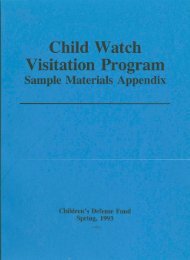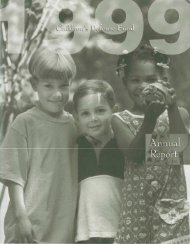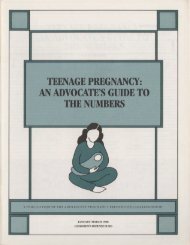children out of school in america - University of Tennessee Digital ...
children out of school in america - University of Tennessee Digital ...
children out of school in america - University of Tennessee Digital ...
You also want an ePaper? Increase the reach of your titles
YUMPU automatically turns print PDFs into web optimized ePapers that Google loves.
dren. Through <strong>out</strong>reach efforts, 7,400 excluded<br />
mentally retarded <strong>children</strong> were found. ll The District<br />
<strong>of</strong> Columbia similarly identified at least 848<br />
<strong>children</strong> who had been excluded.'2 Even though<br />
<strong>of</strong>ficials pr<strong>of</strong>essed to have found all those <strong>in</strong> need <strong>of</strong><br />
services, we found mentally retarded <strong>children</strong> who<br />
had never been to <strong>school</strong> <strong>in</strong> the D.C. Census tract<br />
we surveyed.<br />
Outreach efforts highlight all the problems <strong>of</strong><br />
identify<strong>in</strong>g special needs <strong>children</strong>. First, there are<br />
differences among <strong>children</strong> that require different<br />
programs <strong>of</strong> treatment. Rarely are these def<strong>in</strong>itions<br />
clear and explicit, either at the federal, state, or<br />
local level. Rarely are they consistent across districts<br />
or states. IS Therefore, try<strong>in</strong>g to estimate <strong>in</strong>cidence<br />
<strong>of</strong> a particular problem or need for services is an<br />
imprecise and <strong>of</strong>ten frustrat<strong>in</strong>g exercise. One example<br />
<strong>of</strong> the confusion that can result happened <strong>in</strong><br />
Floyd County, Kentucky. OCR's Annual School<br />
Survey asked for <strong>in</strong>formation on <strong>children</strong> who were<br />
"severely emotionally disturbed, socially maladjusted,<br />
underachievers, and slow learners" with<strong>out</strong> further<br />
def<strong>in</strong>itions. The Floyd County <strong>school</strong> district <strong>in</strong>cluded<br />
<strong>in</strong> their report to OCR over 2,500 students<br />
who were enrolled <strong>in</strong> Title I remedial read<strong>in</strong>g programs.<br />
Sumter County No.2, <strong>in</strong> S<strong>out</strong>h Carol<strong>in</strong>a, also<br />
seems to have reported students <strong>in</strong> its Title I remedial<br />
read<strong>in</strong>g and math programs <strong>in</strong> these special<br />
education categories <strong>in</strong> their report to OCR. This<br />
error is understandable <strong>in</strong> view <strong>of</strong> the lack <strong>of</strong> precision<br />
at OCR and at the local district level <strong>in</strong> def<strong>in</strong><strong>in</strong>g<br />
special needs. Yet it is not trivial. It misleads<br />
<strong>of</strong>ficials ab<strong>out</strong> how many <strong>children</strong> <strong>in</strong> <strong>school</strong> need<br />
and actually are receiv<strong>in</strong>g special services.<br />
11 David Kirp, William Buss, and Peter Kurilotf, "Legal<br />
Reform <strong>of</strong> Special Education," California Law Review,<br />
Vol. 62 (January, 1974) p. 63.<br />
12 Interview with Merle Van Dyke, Assistant Super<strong>in</strong>tendent,<br />
Special Education, Wash<strong>in</strong>gton, D.C., 3/7/74.<br />
13 For the purpose <strong>of</strong> programs funded under the Education<br />
<strong>of</strong> the Handicapped Act, the Bureau <strong>of</strong> Education for the<br />
Handicapped, U.S. Department <strong>of</strong> Health, Education and<br />
Welfare, def<strong>in</strong>es "handicapped <strong>children</strong>" to mean "mentally<br />
retarded, hard <strong>of</strong> hear<strong>in</strong>g, deaf, speech impaired, visually<br />
handicapped, seriously emotionally disturbed, crippled, or<br />
other health impaired <strong>children</strong> who by reason there<strong>of</strong> require<br />
special education and related services. The term <strong>in</strong>cludes<br />
<strong>children</strong> with specific learn<strong>in</strong>g disabilities to the<br />
extent that such <strong>children</strong> are health impaired <strong>children</strong> who<br />
by reason there<strong>of</strong> require special education and related<br />
services." 45 C.F.R. §121.2.<br />
We found estimates <strong>of</strong> need vary<strong>in</strong>g greatly. On<br />
a national level, HEW's Bureau <strong>of</strong> Education for<br />
the Handicapped said that <strong>in</strong> 1971-72, only 44 percent<br />
<strong>of</strong> handicapped <strong>children</strong> ages 0-21 were be<strong>in</strong>g<br />
served <strong>in</strong> public <strong>school</strong>s or state-supported <strong>in</strong>stitutions.<br />
A Rand study for HEW estimated that 59<br />
percent <strong>of</strong> handicapped <strong>children</strong> ages 5-17 were be<strong>in</strong>g<br />
served <strong>in</strong> public <strong>school</strong>s dur<strong>in</strong>g the 1972-73<br />
<strong>school</strong> year. 14<br />
On a local level, while most <strong>school</strong> <strong>of</strong>ficials we<br />
visited could tell us what k<strong>in</strong>ds <strong>of</strong> programs they<br />
had <strong>in</strong> their districts, they could tell us virtually<br />
noth<strong>in</strong>g ab<strong>out</strong> the number <strong>of</strong> <strong>children</strong> be<strong>in</strong>g served<br />
by these programs or the number <strong>of</strong> <strong>children</strong> need<strong>in</strong>g<br />
such programs. Precise data did not exist even<br />
where there was an obligation to conduct a general<br />
<strong>school</strong> census or a special census <strong>of</strong> handicapped<br />
<strong>children</strong>. For example, <strong>in</strong> S<strong>out</strong>h Carol<strong>in</strong>a "each district<br />
is directed to conduct a survey <strong>of</strong> the educational<br />
needs <strong>of</strong> all handicapped <strong>children</strong>" under the<br />
recently enacted S<strong>out</strong>h Carol<strong>in</strong>a Mandatory Education<br />
Act for the Handicapped. However, <strong>school</strong><br />
districts were given the option to project needs based<br />
on their own <strong>in</strong>tradistrict survey and/or on <strong>in</strong>cidence<br />
figures set forth by the state. S<strong>in</strong>ce Sumter County<br />
No.2 chose to rely on state <strong>in</strong>cidence figures, and<br />
did not conduct a survey, <strong>of</strong>ficials there had no notion<br />
<strong>of</strong> the number <strong>of</strong> <strong>children</strong> eligible to receive<br />
services under the law. Richland County School<br />
District No. 1 also relied on <strong>in</strong>cidence figures' prepared<br />
by the state and consequently the actual service<br />
needs <strong>in</strong> this <strong>school</strong> district rema<strong>in</strong> <strong>in</strong>determ<strong>in</strong>ate.<br />
Floyd County, Kentucky <strong>of</strong>ficials purported to<br />
conduct a general house-to-house census each spr<strong>in</strong>g<br />
which <strong>in</strong>cluded handicapped <strong>children</strong>. But the counts<br />
are notoriously <strong>in</strong>accurate. These censuses are conducted<br />
by teachers on their own time and with no<br />
extra help or compensation. Families liv<strong>in</strong>g at the<br />
heads <strong>of</strong> the hollow, or several miles <strong>of</strong>f a creek,<br />
simply are not counted. Unfortunately, it is <strong>children</strong><br />
<strong>in</strong> such remote locations that are likely to be <strong>out</strong> <strong>of</strong><br />
<strong>school</strong>.<br />
14 See Kakalik, Services for Handicapped Y<strong>out</strong>h: A Program<br />
Overview, pp. 112-118. The discrepancy <strong>in</strong> these figures<br />
may be caused by the reports <strong>in</strong>clud<strong>in</strong>g different age<br />
group<strong>in</strong>gs or it may be caused by new services for handicapped<br />
<strong>children</strong> provided <strong>in</strong> the last several years.<br />
95














